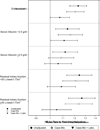Serum Magnesium Levels and Hospitalization and Mortality in Incident Peritoneal Dialysis Patients: A Cohort Study
- PMID: 27261330
- PMCID: PMC5035573
- DOI: 10.1053/j.ajkd.2016.03.428
Serum Magnesium Levels and Hospitalization and Mortality in Incident Peritoneal Dialysis Patients: A Cohort Study
Abstract
Background: Prior studies have shown the association of low serum magnesium levels with adverse health outcomes in patients undergoing hemodialysis. There is a paucity of such studies in patients undergoing peritoneal dialysis (PD).
Study design: Cohort study.
Setting & participants: 10,692 patients treated with PD from January 1, 2007, through December 31, 2011, in facilities operated by a single large dialysis organization in the United States.
Predictor: Baseline serum magnesium levels, examined as 5 categories (<1.8, 1.8-<2.0, 2.0-<2.2 [reference], 2.2-<2.4, and ≥2.4mg/dL).
Outcomes: Time to first hospitalization and time to death using competing-risks regression models.
Results: The distribution of baseline serum magnesium levels in the cohort was <1.8mg/dL, 1,928 (18%); 1.8 to <2.0mg/dL, 2,204 (21%); 2.0 to <2.2mg/dL, 2,765 (26%); 2.2 to <2.4mg/dL, 1,765 (16%); and ≥2.4mg/dL, 2,030 (19%). Of 10,692 patients, 6,465 (60%) were hospitalized at least once and 1,392 (13%) died during follow-up (median, 13; IQR, 7-23 months). Baseline serum magnesium level < 1.8mg/dL was associated with higher risk for hospitalization and all-cause mortality after adjustment for demographic and clinical characteristics (adjusted HRs of 1.23 [95% CI, 1.14-1.33] and 1.21 [95% CI, 1.03-1.42], respectively). The higher risk for hospitalization persisted upon adjustment for laboratory variables, whereas that for all-cause mortality was attenuated to a nonsignificant level. The greatest risk for hospitalization was in patients with low serum albumin levels (<3.5g/dL; P for interaction < 0.001).
Limitations: Possibility of residual confounding by unmeasured variables cannot be excluded.
Conclusions: Lower serum magnesium levels may be associated with higher risk for hospitalization in incident PD patients, particularly those with hypoalbuminemia. Additional studies are needed to confirm these findings and investigate whether correction of hypomagnesemia reduces these risks.
Keywords: Magnesium; all-cause mortality; end-stage renal disease (ESRD); hospitalization; hypomagnesemia; incident PD patients; peritoneal dialysis (PD).
Copyright © 2016 National Kidney Foundation, Inc. Published by Elsevier Inc. All rights reserved.
Figures





Similar articles
-
Hypomagnesemia and Mortality in Incident Hemodialysis Patients.Am J Kidney Dis. 2015 Dec;66(6):1047-55. doi: 10.1053/j.ajkd.2015.05.024. Epub 2015 Jul 14. Am J Kidney Dis. 2015. PMID: 26184377 Free PMC article.
-
Mortality, Hospitalization, and Technique Failure in Daily Home Hemodialysis and Matched Peritoneal Dialysis Patients: A Matched Cohort Study.Am J Kidney Dis. 2016 Jan;67(1):98-110. doi: 10.1053/j.ajkd.2015.07.014. Epub 2015 Aug 28. Am J Kidney Dis. 2016. PMID: 26319755
-
Uncorrected and Albumin-Corrected Calcium, Phosphorus, and Mortality in Patients Undergoing Maintenance Dialysis.J Am Soc Nephrol. 2015 Jul;26(7):1671-81. doi: 10.1681/ASN.2014050472. Epub 2015 Jan 22. J Am Soc Nephrol. 2015. PMID: 25613037 Free PMC article.
-
First-year outcomes of incident peritoneal dialysis patients in the United States.Am J Kidney Dis. 2014 Nov;64(5):761-9. doi: 10.1053/j.ajkd.2014.04.025. Epub 2014 Jun 11. Am J Kidney Dis. 2014. PMID: 24927898
-
Association between hypomagnesemia and mortality among dialysis patients: a systematic review and meta-analysis.PeerJ. 2022 Oct 11;10:e14203. doi: 10.7717/peerj.14203. eCollection 2022. PeerJ. 2022. PMID: 36248710 Free PMC article.
Cited by
-
Detecting Secular Trends in Clinical Treatment through Temporal Analysis.J Med Syst. 2019 Feb 12;43(3):74. doi: 10.1007/s10916-019-1173-0. J Med Syst. 2019. PMID: 30756197
-
Serum magnesium, mortality, and cardiovascular disease in chronic kidney disease and end-stage renal disease patients: a systematic review and meta-analysis.J Nephrol. 2019 Oct;32(5):791-802. doi: 10.1007/s40620-019-00601-6. Epub 2019 Mar 19. J Nephrol. 2019. PMID: 30888644
-
Magnesium: A Magic Bullet for Cardiovascular Disease in Chronic Kidney Disease?Nutrients. 2019 Feb 22;11(2):455. doi: 10.3390/nu11020455. Nutrients. 2019. PMID: 30813254 Free PMC article. Review.
-
Prognostic Value of Serum Magnesium in Mortality Risk among Patients on Hemodialysis: A Meta-Analysis of Observational Studies.Kidney Dis (Basel). 2021 Jan;7(1):24-33. doi: 10.1159/000510513. Epub 2020 Nov 4. Kidney Dis (Basel). 2021. PMID: 33614731 Free PMC article.
-
Elevated Serum Magnesium Levels May Delay the Loss of Residual Renal Function among Patients Receiving Peritoneal Dialysis: A Prospective Study.Biol Trace Elem Res. 2025 Jul;203(7):3559-3569. doi: 10.1007/s12011-024-04432-w. Epub 2024 Oct 30. Biol Trace Elem Res. 2025. PMID: 39477852
References
-
- Ayuk J, Gittoes NJ. Contemporary view of the clinical relevance of magnesium homeostasis. Ann Clin Biochem. 2014;51:179–188. - PubMed
-
- Lowenstein FW, Stanton MF. Serum magnesium levels in the United States, 1971–1974. Journal of the American College of Nutrition. 1986;5:399–414. - PubMed
-
- Alhosaini M, Leehey DJ. Magnesium and Dialysis: The Neglected Cation. Am J Kidney Dis. 2015;66:523–531. - PubMed
-
- Kanbay M, Yilmaz MI, Apetrii M, et al. Relationship between serum magnesium levels and cardiovascular events in chronic kidney disease patients. Am J Nephrol. 2012;36:228–237. - PubMed
-
- Van Laecke S, Nagler EV, Verbeke F, Van Biesen W, Vanholder R. Hypomagnesemia and the risk of death and GFR decline in chronic kidney disease. Am J Med. 2013;126:825–831. - PubMed
Publication types
MeSH terms
Substances
Grants and funding
LinkOut - more resources
Full Text Sources
Other Literature Sources
Medical

